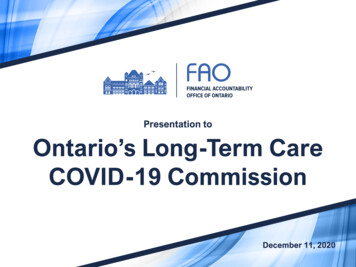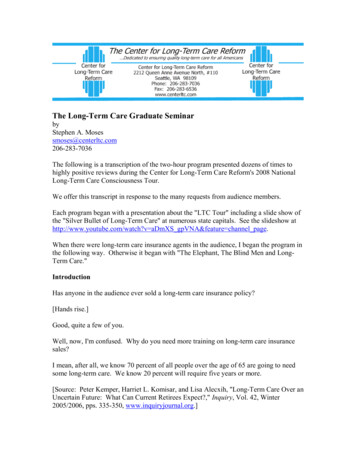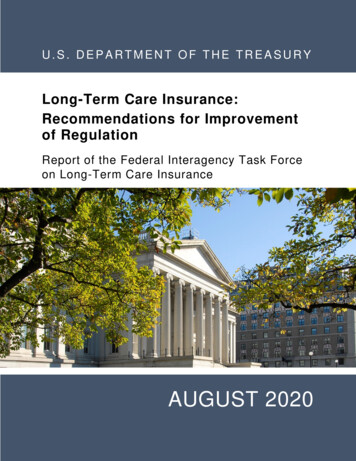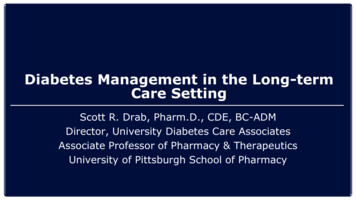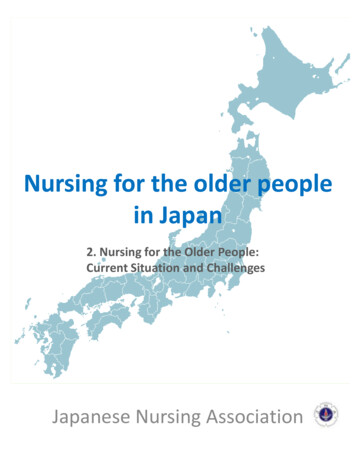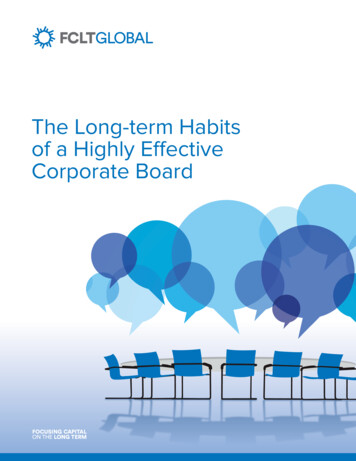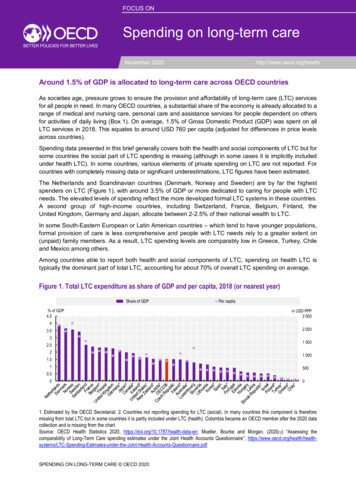
Transcription
FOCUS ONSpending on long-term careF 1November 2020http://www.oecd.org/healthAround 1.5% of GDP is allocated to long-term care across OECD countriesAs societies age, pressure grows to ensure the provision and affordability of long-term care (LTC) servicesfor all people in need. In many OECD countries, a substantial share of the economy is already allocated to arange of medical and nursing care, personal care and assistance services for people dependent on othersfor activities of daily living (Box 1). On average, 1.5% of Gross Domestic Product (GDP) was spent on allLTC services in 2018. This equates to around USD 760 per capita (adjusted for differences in price levelsacross countries).Spending data presented in this brief generally covers both the health and social components of LTC but forsome countries the social part of LTC spending is missing (although in some cases it is implicitly includedunder health LTC). In some countries, various elements of private spending on LTC are not reported. Forcountries with completely missing data or significant underestimations, LTC figures have been estimated.The Netherlands and Scandinavian countries (Denmark, Norway and Sweden) are by far the highestspenders on LTC (Figure 1), with around 3.5% of GDP or more dedicated to caring for people with LTCneeds. The elevated levels of spending reflect the more developed formal LTC systems in these countries.A second group of high-income countries, including Switzerland, France, Belgium, Finland, theUnited Kingdom, Germany and Japan, allocate between 2-2.5% of their national wealth to LTC.In some South-Eastern European or Latin American countries – which tend to have younger populations,formal provision of care is less comprehensive and people with LTC needs rely to a greater extent on(unpaid) family members. As a result, LTC spending levels are comparably low in Greece, Turkey, Chileand Mexico among others.Among countries able to report both health and social components of LTC, spending on health LTC istypically the dominant part of total LTC, accounting for about 70% of overall LTC spending on average.Figure 1. Total LTC expenditure as share of GDP and per capita, 2018 (or nearest year)Share of GDP% of GDP4.5Per capitain USD PPP2 50043.532.521.512 0001 5001 0005000.5001. Estimated by the OECD Secretariat. 2. Countries not reporting spending for LTC (social). In many countries this component is thereforemissing from total LTC but in some countries it is partly included under LTC (health). Colombia became an OECD member after the 2020 datacollection and is missing from the chart.Source: OECD Health Statistics 2020, https://doi.org/10.1787/health-data-en; Mueller, Bourke and Morgan. (2020[1]) “Assessing thecomparability of Long-Term Care spending estimates under the Joint Health Accounts Questionnaire”, stionnaire.pdf.SPENDING ON LONG-TERM CARE OECD 2020
2 Governments and social insurance cover the bulk of the costs of long-term careprovisionThe two main modes of provision for LTC are either inpatient care in a residential facility or care provided inthe patient’s home. In most OECD countries, the costs for both types of care are covered to a great extent (4out of every 5 dollars spent on LTC on average) by either a government scheme (such as a National HealthService or regional health boards) or through compulsory insurance (mainly social insurance), with inpatientcare generally less well covered by government or compulsory insurance than home care (Figure 2).Figure 2. Share of public spending for different LTC services, 2018 (or nearest year)Total LTCInpatient LTCHome-based LTC100%80%60%40%1. Countries that do not report LTC (social).Source: OECD Health Statistics 2020, https://doi.org/10.1787/health-data-en.Box 1. What is included in LTC spending?A System of Health Accounts 2011 defines total long-term care expenditure as the sum of long-termcare (health) and long-term care (social) (OECD/Eurostat/WHO, 2017[1]).LTC (health) includes medical or nursing care (e.g. wound dressing, administering medication, healthcounselling, palliative care, and medical diagnosis with relation to a LTC condition), and personal careservices which provide help with activities of daily living (ADL), such as support with food intake,bathing, washing, dressing, getting out of bed, and managing incontinence.LTC (social) consists of assistance services that enable a person to live independently. They relate tohelp with instrumental activities of daily living (IADL) such as shopping, cooking and performinghousework. It also includes subsidies to residential services in assisted living facilities (as well asexpenditure on accommodation).LTC (health) can be further broken down into the key modes of provision: inpatient LTC (mainly innursing homes) and home-based LTC (when care is delivered at people’s homes).LTC services can be provided by a range of health professionals and institutions but also by familymembers in case a care allowance is paid. Uncompensated work by informal carers is excluded.SPENDING ON LONG-TERM CARE OECD 2020
3Countries with high LTC spending overall – Denmark, Sweden, the Netherlands and Norway – also tendto be those with the highest public share (at 92-94%). At the other end of the scale, public financing inEstonia and Portugal only covers around 60% or less of overall LTC spending.In all but three countries (Belgium, Finland and Slovenia), public financing covers a higher proportion ofhome-based care costs compared with inpatient care, typically because some or all of the costs for roomand board are borne by residents themselves. On average across the OECD, 75% of inpatient LTC isfinanced by public or compulsory schemes compared to more than 90% for home-based care. The gap ismore pronounced in Estonia, Portugal, the United Kingdom and Italy, where there is a 30-percentage pointdifference or more between the two.The public share of inpatient LTC costs is less than half in Estonia and Portugal and below 60% in theUnited Kingdom and Germany. By contrast, more than 90% of inpatient spending is publicly covered inSlovenia, Sweden, Belgium and the Netherlands. Without adequate social protection, the high costs forLTC can represent a significant financial burden for people with LTC needs (Oliveira Hashiguchi and LlenaNozal, 2020[1]).The majority of spending on long-term care is in residential facilitiesResidential facilities such as nursing homes constitute the major provider of LTC in nearly allOECD countries, mainly delivering inpatient LTC services but also offering home-based LTC or help withinstrumental activities of daily living in some countries (Figure 3). They account for around 80% of all LTCspending in the Netherlands, the highest overall LTC spender. The share is above 70% in Switzerland,Slovenia and France. In Korea and Portugal, which spend much less overall on LTC, less than 20% isrelated to care in residential facilities. Three-quarters of LTC spending in Portugal is linked to providerspredominantly from the social care sector.Almost two-thirds of LTC spending in Korea is on hospital-based care. Hospitals are also a non-negligibleLTC provider in Japan (24% of all spending), Canada, Spain, Estonia and Latvia (12-16%). While hospitallike facilities play a historical role in the organisation of LTC in Japan and Korea, a high share could pointto shortages in alternative lower-level care facilities for people with inpatient LTC needs in some countries.In Norway, Denmark and Belgium, all with very high LTC spending levels, ambulatory home care providersplay an important role in LTC provision. They account for around 40% or more of total LTC spending. Bycontrast, this type of provider plays only a minor role in LTC provision in Estonia and Lithuania.Many countries have specific policies to finance informal LTC provision at home. In these countries, LTCdependent persons can choose to be cared for by friends or family members and receive a care allowancefor this purpose. This makes up more than a third of all LTC spending in Lithuania and Austria and standsat around 20% in Ireland and Germany.SPENDING ON LONG-TERM CARE OECD 2020
4 Figure 3. Total long-term care spending broken down by provider, 2018 (or nearest year)Nursing homeHospitalHome careHouseholdsSocial provdersOther100%80%60%40%20%0%1. Countries not reporting social LTC. 2. Countries where social LTC cannot be allocated to providers (included in “Other”). 3. No breakdown ofambulatory service providers (included in “Other”).Source: OECD Health Statistics 2020, https://doi.org/10.1787/health-data-en.LTC spending has outpaced overall health spending and GDP growth in mostOECD countriesThe share of LTC spending in total health spending or as a share of GDP has gradually increased overthe last 15 years in many OECD countries as demand for care grows with population ageing and theextension of publicly financed services.In Germany, for example, LTC spending as a share of GDP has increased from 1.5% in 2005 to 2.1% in2018 (Figure 4). In parallel with population ageing, the frequent adjustment of LTC benefits and a wideningof the definition of LTC dependency has expanded the entitlement for services for people with dementia inparticular.The situation in Korea has been even more dynamic. From a very low base, the share of LTC in GDP grewsharply, from 0.1% to 1.0% between 2005 and 2018, now close to the OECD average. This reflects specificefforts to move away from informal LTC provision in a relatively short period of time. Spending on LTC hasbeen increasing by more than 25% per year (in real terms) over this period.In some countries, spending on LTC has not grown much faster than the economy as a whole. In Sloveniaand Spain, for example, the shares of LTC relative to GDP in 2018 were only 0.1-0.2 percentage pointsabove those in 2005, at 1.2% and 0.9% of GDP, respectively. In Slovenia, the share increased between2006 and 2011 and has remained mainly flat since. In Spain, the share of LTC spending has beenstagnating since 2009, with LTC spending tracking GDP growth.In the Netherlands, LTC spending has historically been very high, reflecting the very generous benefitbasket for LTC-dependent people. It already stood at 3.4% of GDP in 2005 but has been increasing furtherto reach 3.9% by 2018, despite a drop of this share in 2015 corresponding to an important LTC reform inthe country. Financing responsibilities for LTC were transferred from central authorities to the local level in2015, services re-oriented towards home care and expenditure adjusted. This led to a 8% drop in inpatientLTC spending (in real terms). Since then, spending on inpatient LTC has returned to positive growth.SPENDING ON LONG-TERM CARE OECD 2020
5Figure 4. Share of total long-term care spending in GDP, selected countries, 2005-18SloveniaGermany¹Korea¹NetherlandsSpain% of 120122013201420152016201720181. Country does not report LTC (social).Source: OECD Health Statistics 2020, https://doi.org/10.1787/health-data-en. Data for Slovenia 2012 estimated by the OECD Secretariat.ReferencesMueller, M., E. Bourke and D. Morgan (2020), “Assessing the comparability of Long-TermCare spending estimates under the Joint Health Accounts Questionnaire”, Technical report,OECD, Paris, stionnaire.pdf.[3]OECD/Eurostat/WHO (2017), A System of Health Accounts 2011: Revised edition, OECDPublishing, Paris, veira Hashiguchi, T. and A. Llena-Nozal (2020), “The effectiveness of social protection forlong-term care in old age: Is social protection reducing the risk of poverty associated withcare needs?”, OECD Health Working Papers, No. 117, OECD Publishing, eful LinksOECD Health Statistics 2020: , https://doi.org/10.1787/health-data-enOECD work on LTC: ctMichael MUELLER ( michael.mueller@oecd.org)David MORGAN ( david.morgan@oecd.org)SPENDING ON LONG-TERM CARE OECD 2020
6 This policy brief should not be reported as representing the official views of the OECD or of its member countries. The opinions expressed and argumentsemployed are those of the authors.This document and any map included herein are without prejudice to the status of or sovereignty over any territory, to the delimitation of internationalfrontiers and boundaries and to the name of any territory, city or area.The statistical data for Israel are supplied by and under the responsibility of the relevant Israeli authorities. The use of such data by the OECD is withoutprejudice to the status of the Golan Heights, East Jerusalem and Israeli settlements in the West Bank under the terms of international law.The use of this work, whether digital or print, is governed by the Terms and Conditions to be found at http://www.oecd.org/termsandconditions.SPENDING ON LONG-TERM CARE OECD 2020
A System of Health Accounts 2011 defines total long-term care expenditure as the sum of long-term care (health) and long-term care (social) (OECD/Eurostat/WHO, 2017 [1]). LTC (health) includes medical or nursing care (e.g. wound dressing, administering medication, health counselling, palliative care, and medical diagnosis with relation to a LTC .
